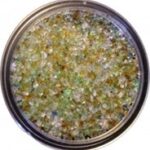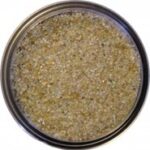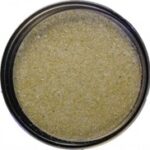Recycled Crushed Glass Abrasive Not just for Slurry Blasting
- September 13, 2020
- Posted by: Keith Gabbard
- Category: Abrasive Knowledge
Wet Abrasive Blasting:
Slurry Blast surface preparation is sometimes the preferred method of Abrasive Blasting – particularly where very low dust levels are imperative – as compared to Dry Blasting.
There are a few excellent Slurry Blast units available today, including Dustless Blasting, Graco Vapor Blast & Clemco WetBlast Flex, among others. While everyone of the units is distinct from the others, all Slurry Blast units have one commonality: the main Abrasive used for Slurry Blasting is Recycled Crush Glass (RCG).



The reasons RCG is typically the preferred Abrasive for Slurry Blasting are as follows:
- Low Density – RCG is around 80 lbs/cuft – which allows easy mixing – and suspension – with water.
- Low Density also means that RCG can be used on sheet metal with minimal warping potential.
- RCG has an Off-White color – Blasters will sometimes leave residue on the ground rather than completely pick up and haul to landfill.
- RCG is angular (rather than rounded), and despite the relative lightweight is still effective at removing corrosion, paint and other surface contaminates.
- Relatively low cost compared to Garnet or Aluminum Oxide Abrasives.
- Very, very low free silica content or other Hazardous contaminates in the RCG blend.
- Extremely clean blast surface appearance – white look.
For Slurry Blasting, the cons associated with the use RCG are:
- Friability – the RCG crystal breaks down more easily with impact.
- MOH Hardness of 6 approximate. Some of the other Abrasives are harder.
- Medium Production Rate is typical with RCG Slurry Blasting.
Dry Abrasive Blasting:
RCG Abrasive is also becoming more popular with Dry Abrasive Blasting operations as well. Some of the same benefits for Slurry Blasting are also beneficial for Dry Abrasive Blasting, specifically:
- RCG has an Off-White color – Blasters will sometimes leave residue on the ground rather than completely pick up and haul to landfill.
- Extremely clean blast surface appearance – white look.
- RCG is angular (rather than rounded), and despite its lightweight is still effective at removing corrosion, paint and other.
- Relatively low cost compared to Garnet or Aluminum Oxide Abrasives.
- Very low free silica content or other Hazardous contaminates in the RCG blend.
- RCG can be used on sheet metal with minimal warping potential.
Some issues that might concern Dry Blasters using RCG include:
- Fracturing RCG will create some dust – more than Garnet or Aluminum Oxide.
- RCG will be somewhat slower Production than less dusty abrasives.
Even with the few negatives, the advantages of a super clean blast profile, and the ability to leave some of the spent RCG on the ground – combined with the environmentally friendly nature of RCG – present opportunities for RCG use with both Wet or Dry Blast operations.
Conclusion:
All Blast Media individually have beneficial features (low dust, low cost, clean blast profile, lower Consumption Rates, etc.) – and some drawbacks (more dusty, higher cost, lower Production Rates, etc.).
Depending on the specific project, several Abrasive Media can be compared in order to optimize the specific job needs.
So, please contact TCR Blast Abrasives to discuss the use of Recycled Crush Glass – or any the other Abrasive Media suited for your project.
